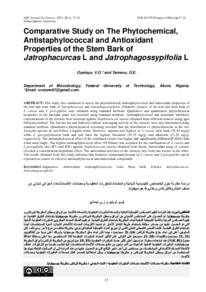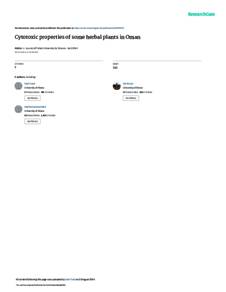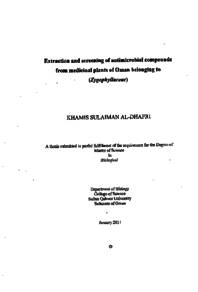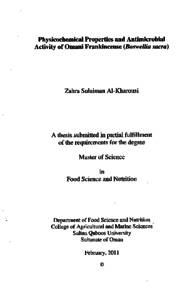وثيقة
Toxicological evaluation of the leaves of mangifera indica L. (mango) on albino rats (rattus norvegicus).
المعرف
https://doi.org/10.53539/squjs.vol28iss1pp1-9
المصدر
Sultan Qaboos University Journal for Scientific. v. 28, no. 1, p. 1-9.
المساهمون
Salisu, Titilola F., مؤلف
Oladele, Esther O., مؤلف
Yaro, Clement., مؤلف
Tukur, Adam., مؤلف
Izuafa, Abdulrazaq., مؤلف
Yari, Muhammad A., مؤلف
عناوين أخرى
تقييم السموم في أوراق مانغيفيرا إنديكال مانجو (على جرذان ألبينو) راتوس نورفيغيكوس.
الدولة
Oman.
مكان النشر
Muscat.
الناشر
College of Science, Sultan Qaboos University.
ميلادي
2023-01-01
اللغة
الأنجليزية
الموضوع
الملخص الإنجليزي
The increasing use of plant-based medicines necessitates safety evaluations of all medicinal plants. This study evaluated the effects of mango (Mangifera indica) leaf extracts on albino rats (Rattus norvegicus). The phytochemistry of the plant’s extract was evaluated, followed by a determination of its acute toxicity using 24 rats. Thereafter, the chronic toxicity of the extract was determined using another set of 24 rats, separated into four groups of six rats each. Rats in group 1 (the control) were administered distilled water, while groups 2, 3, and 4 received daily doses of 1000, 2000, and 3000 mg kg-1 body weight, respectively. The rats’ body weights and reactions were monitored for 90 days before blood, liver, and kidney samples were collected for hematological and histopathological examinations. The phytochemistry revealed phenols, alkaloids, tannins, flavonoids, steroids, glycosides, and saponins. The acute toxicity test recorded no mortality at doses up to 5000 mg kg-1, and all the rats behaved normally, except for one that was sluggish. The chronic toxicity test revealed no significant (p>0.05) weight difference between the control and treated rats. The packed cell volume, hemoglobin, and red and white blood cells of the rats fed 2000 and 3000 mg were significantly altered (p0.05), while lymphocytes exhibited no significant alterations in any of the groups. The treated rats’ livers revealed dose-dependent necrosis, whereas their kidneys showed atrophy and epithelial cell degeneration. The results obtained suggest that a single dose of the plant’s extract is not harmful, but repeated high-concentration dosing for a long time may result in toxicity.
ISSN
2414-536X
الملخص العربي
يتطلب الاستخدام المتزايد للأدوية النباتية إجراء تقييمات للسلامة لجميع النباتات الطبية. قيمت هذه الدراسة تأثير مستخلصات أوراق المانجو (Mangifera indica) على الجرذان البيضاء (Rattus norvegicus). تم تقييم الكيمياء النباتية لمستخلص النبات، ثم تحديد سميته الحادة باستخدام 24 فأراً. بعد ذلك، تم تحديد السمية المزمنة للمستخلص باستخدام مجموعة أخرى مكونة من 24 فأرًا، تم تقسيمها إلى أربع مجموعات تضم كل منها ستة فئران. تم إعطاء الفئران في المجموعة 1 (التحكم) الماء المقطر، في حين تلقت المجموعات 2 و 3 و 4 جرعات يومية قدرها 1000 و 2000 و 3000 ملغم من وزن الجسم على التوالي. تمت مراقبة أوزان الجسم وردود أفعال الفئران لمدة 90 يومًا قبل جمع عينات الدم والكبد والكلى لإجراء فحوصات الدم والنسيج المرضي. كشفت الكيمياء النباتية عن الفينولات والقلويدات والعفص والفلافونويدات والمنشطات والجليكوسيدات والصابونين. لم يسجل اختبار السمية الحادة أي وفيات عند تناول جرعات تصل إلى 5000 ملجم/كجم، وتصرفت جميع الفئران بشكل طبيعي، باستثناء واحدة كانت بطيئة. أظهر اختبار السمية المزمنة عدم وجود فرق كبير (P>0.05) في الوزن بين الفئران الضابطة والفئران المعالجة. تم تغيير حجم الخلايا المعبأة والهيموجلوبين وخلايا الدم الحمراء والبيضاء للفئران التي تم تغذيتها بجرعة 2000 و3000 ملغ بشكل ملحوظ (P <0.05)، في حين لم تظهر الخلايا الليمفاوية أي تغيرات مهمة في أي من المجموعات. وكشفت كبد الفئران المعالجة عن نخر يعتمد على الجرعة، في حين أظهرت كليتيها ضمورًا وانحطاط الخلايا الظهارية. تشير النتائج التي تم الحصول عليها إلى أن جرعة واحدة من مستخلص النبات ليست ضارة، ولكن تكرار الجرعات عالية التركيز لفترة طويلة قد يؤدي إلى التسمم.
قالب العنصر
مقالات الدوريات




